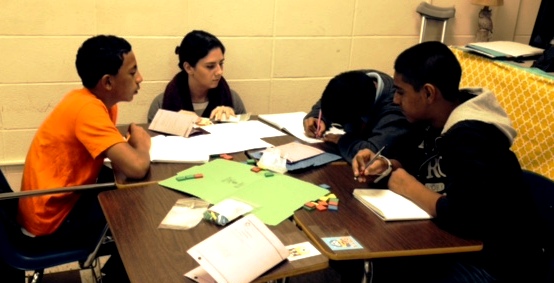“If you have a candle, the light won’t glow any dimmer if I light yours off of mine.” -Steven Tyler, Aerosmith
A participant in a recent Tabor Rotation Institute asked me this question,
“Why is simultaneous interaction so important?”
Jeff Sapp writes about the transformational power of simultaneous interaction in at-risk schools in the Electronic Journal of Science Education, Number 30: Fall, 2006. One of these schools states, “Student interaction at every level of school fosters comfort and confidence..it increases academic achievement and equips students with the ability to speak across lines of race, class, and gender.
Sapp also found that group activities radically altered the typical teacher-fronted classroom’s sequential interaction. Instead of one person speaking at a time, one person per group or many pairs were discussing simultaneously, hence the term used frequently by Spencer Kagan, “simultaneous interaction.”
Simultaneous Interaction is included in the Tabor Rotation Framework as one of its 14 Essential Elements because it has proven to be highly effective in all three phases of Tabor Rotation. When I first created the Tabor Rotation Framework I knew that the components of balanced literacy needed to be included in the components for balanced mathematics. In fact, in the book, Cases of Successful Literacy Teachers, Lacina and Silva found that every successful teacher they studied believed that social interaction is critical to oral language development. A math classroom, filled with complex vocabulary and challenging concepts, is no different.
After attempting to implement simultaneous interaction back in her own classroom, the same teacher emailed me with this next question.
“I believe that simultaneous interaction in essential, but how do I make sure my students do it?”
Here are my Top Ten for Encouraging Simultaneous Interaction:
1. Model, model, model! Provide an exemplar for your students. When working with a group at the Teacher Time Station, model how to ask questions of a partner and how to actively listen. Show video clips of people interacting effectively.
2. Practice what you modeled. Students need to see the model and then practice with their partner and their team. Make it a purposeful practice that reflects what they should be discussing during the Whole-Group Mini-Lesson or during station rotations.
3. Assign partners for Whole-Group Mini-Lessons and in Teams. I assign partners based upon their complimentary abilities to communicate with each other. Having an assigned partner eliminates student concern when a teacher states, “Turn to someone next to you and share.”
4. Extrinsically reward appropriate interaction. A teacher can observe group and partner interaction, note those behaviors, then give teams points for the positive behaviors. The responsibility of observing effective simultaneous interaction could also be assigned to a team member, noted, and then shared with the whole group.
5. Write specific questions you want students to ask each other. This could be as simple as putting the questions each student asks their partner or team on a sticky note and placing it on the Leader Folder.
6. Cultivate active listening techniques in your classroom. Teach students how to have positive facial expressions, physically turning toward the person speaking, and responding in a way that the person knows you’re listening.
7. Schedule times to have students stop and interact. Many teachers write notes to themselves in their lesson plans or set a timer that reminds them to stop and let students share what they have learned so far.
8. Post key statements that help students encourage each other in a discussion. Two of these are “How did you know that?” and “Explain your thinking.”
9. Accept and encourage the “hum of productivity.” Classrooms where students interact and discuss will not be silent. They will have a positive hum of discussion, elaboration, and display of understanding.
10. Give opportunities for students to work in varied settings. Some students crave quiet time and working alone. Give them a chance to do this at some point during the day or week.
Begin with…
- Have Materials Managers from each team distribute supplies.
- Stopping every 5-8 minutes and having students share a summary “word” with their partner and why they chose that word.
- Have students practice listening to an answer given by their partner and restating it in their own words.
Why plan for simultaneous interaction? Why make it a purposeful and vital part of your classroom? Noreen Webb, in 1989, conducted research with primary level students learning mathematics in mixed-ability groups. She found that both high and low achievers benefited when lower achievers requested and received explanations, but no one benefited when answers without explanations were provided or requests were ignored.
Simultaneous Interactions provides for active engagement of all students, gives students a chance to regularly process information, and allows students to work together and learn from each other. For those students who only learn if they are talking and interactively engaged, simultaneous interaction is non-negotiable!


